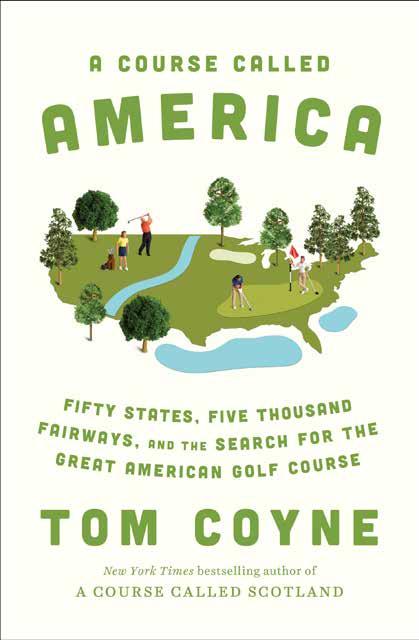
8 minute read
The Bookshelf: Golf in every state
BOOKSHELF One Year, Many Courses; One Course, Many Years
by tom bedell
Advertisement
else, for that matter. want, relatively few details of his actual I’ve read other books about players play (just as we’d want), and scores of ennotching at least one course in every counters with his playing partners, be they
Tom Coyne’s state in a year’s time. But none done with bikers or poets or movie stars or, all, just latest golfa- Coyne’s talent, on the course or at his desk. golfers. palooza, “A In an appendix we learn that his 21,691 Course Called Ameri- strokes on 5,173 holes gave him a round ca” (Avid Reader Press average to par of +6. His highest score was $28), comes on the 90, at the Waynesborough Country Club in soft-spiked heels of his popular golf orgy Pennsylvania. travelogues to Ire- He does play at land and Scotland. least one course in This one kept him every state and any broadly at home in reader will be curi2019 — in the U.S., ous to see how the that is — when he home state fares. spent most of the (He plays only year playing on Southern Hills about 300 courses in Oklahoma, throughout the coun- though there’s try. no blaming him
Or, as the subtitle for that pick.) He puts it, “Fifty States, tees it up in backFive Thousand Fair- yard courses as ways, and the Search well as at exclufor the Great Ameri- sive private clubs can Golf Course.” The he can’t resist, search is one hook, though his another is Coyne’s at- heart seems tempt to play every to be with course that has hosted the former: the U.S. Open. In a “I had seen suspense novel these golf done plot devices would be otherwise, called MacGuffins, use- in villages ful mainly to drive the across the British Isles narrative forward. Or, one suspects in this where every tee was open to a visiting case, to set up tee times. player, but here I was playing the game
Okay, so I started this book of networks and flattery to with the usual chip of Coyne score myself a game. Was I envy on my shoulder: Why a hypocrite? Or was I just a didn’t I think up this great golfer who wanted to play? stunt? And where is this pro- I didn’t write the rules over gram ultimately headed? (“Last here, but I suspected that in the series, A Course Called those who did had missed Antarctica!”) something essential about the
But Coyne easily won me game.” Come the revolution, over, the chip melted clear no more private clubs! away, and what was left was a Coyne has a casual approach sumptuous feast of anecdotes, more about the people he met Tom Coyne to chronology, seemingly leaping around in his narrative along the way than the courses themselves. as unpredictably as he does around the
Other than to say it’s no course you’d country, though he makes it plain the trip expect or have probably even heard of, I was planned, planned again, then planned won’t reveal what takes the Great Ameri- again. He gives us just as many planning can Golf Course honors. It’s more of a piece details as we might want (including the with the ample musing in the book about reactions of his wife, clearly a saint), just the soul of golf, in America or anywhere as many architectural details as we might
THE STORY OF THE MASTERS
It started in 1934, then officially called the Augusta National Invitation Tournament. The 85th version begins April 8, and the chances are good it will be another humdinger. David Barrett’s “The Story of the Masters: Drama, Joy and Heartbreak at Golf’s Most Iconic Tournament” (Tatra Press, $30) will be a good companion. It’s actually 84 detailed stories of the competition, round by round, with yearly charts of the top-10 finishers. Truth be told, in lesser hands this could have been a stultifying reading experience, especially if you go at it from cover to cover as I did. Most won’t — it’s more of a book to dip into for pleasure or reference as needed. Granted, toward the end, I found myself skimming over a few of the details of where players stood after the Friday rounds. But that said, Barrett knows the

territory, having covered many an Augustian tournament himself (we reviewed his early history of the tournament, “Making the Masters,” back in the June-July 2012 issue). Caps off to him for making the book
as readable as it is.
There is a certain tantalizing aspect to reading it straight through. The cumulative effect is like watching a time-lapse film, history sped up, as Horton Smith and Gene Sarazen and Bobby Jones give way to Nelson and Hogan and Snead, who then start to fade as rookie Arnold Palmer appears in 1955, and then blazes like a star as Nicklaus and Gary Player make their entrances. Cue Watson and Ballesteros, Langer, Faldo and the luckless Greg Norman, Couples and Crenshaw, the young Tiger Woods, the young Jordan Spieth, the old Tiger Woods.
Add to this the sense that, in many years, the Masters outcome was often in doubt until the final putt. (Of course, Dustin Johnson blew it away last year, making for one of the dullest tournaments in decades except, no doubt, for him.) That the Masters remains one of golf’s most exciting and suspenseful recurring dramas is probably why we’ve tended to forgive it its once hidebound traditions and insufferable self-importance. (Come the revolution…!)
Lee Elder finally broke the color barrier in 1975, and Tiger Woods underlined that in his extraordinary 12-stroke victory in his professional Masters debut in 1997. But mostly Barrett leaves the societal aspects of the Masters as a background murmur, to concentrate on the play itself. Here, too, the firsts flip by: the first green jacket ceremony in 1949 (to Sam Snead), the first 36hole cut in 1957, the first successful defense of a title — by Nicklaus, who won in 1965 and 1966. (Barrett naturally answers the critical question that arises: “Nicklaus put the jacket on himself.”)
The par-3 contest debuted in 1960, won by Snead (a winner has yet to claim the main tournament title in the same year). Gary Player was the first international winner in 1961. And from 1960-1966 one of The Big Three was a winner: Palmer in ‘60, ‘62 and ‘64, Player in ‘61, Nicklaus in ‘63, ‘65, ‘66. In 1964, Barrett notes, Palmer missed by one stroke being, “...the first player with four rounds in the 60s—a feat that wasn’t accomplished until 2020 when Cameron Smith did it.” (Yet lost to Johnson by five strokes!)
And so it goes, in what will surely be the definitive chronicle of every year of golf’s first major (usually). Until this year’s tournament is over, anyway — in my crystal ball I foresee annual new editions of Barrett’s tome with the latest iteration slipped neatly in. ly received the one-shot penalty. Because he was acting on the advice of the official, Knox was not penalized for failing to replace his ball.
Using Reasonable Judgment
return to a spot much further back to play to play his next shot. Fortunately for Viktor, as he was walking back to play his next shot, video evidence became available confirming Viktor’s assertion that his ball had struck land and had crossed the edge of the Penalty Area where he had estimated.
Rule 1.3b(2) allows a player to use Rea- Unfortunately for Viktor he would later sonable Judgment in determining a loca- receive a two-stroke penalty for failing to tion, such as estimating replace his ball on the where a ball crossed correct spot when his the edge of a Penalty mother, while viewArea. During the first ing the network teleround of the Players cast from Norway, Championship, Viktor informed Viktor that Hovland hit his second he had incorrectly reshot on the par 5 11th placed his ball mark on hole into the red Pen- the putting green and alty Area. Because Vik- subsequently played tor and his caddie were from a wrong place. the only ones to see his While video eviball land on the narrow dence should be used strip of land between a to make correct rulbunker and the Penalty ings, it is simply not Area, Viktor asked for available for 99.9 peran opinion from a rules cent of golfers. The official. Even though modernized rules asthe official did not see Viktor’s second shot Viktor Hovland sume players are hon est and act with in and Viktor was allowed to use reason- tegrity by allowing players to assess all able judgment to determine where his ball reasonably available information, detercrossed the edge of the Penalty Area, the mine virtual certainty, and make reasonrules official informed Viktor that he must able judgments.

WOGA cont. from page 10
ground is in accounting and my husband their WGA Kick Offs. and I ran a safety-and-first aid company
One of the exciting changes WOGA had for 15 years before selling the business and for 2020 was implementing Golf Genius retiring. as our membership/tournament manage- I took up golf in 2000 after retiring and ment program. While it was challenging it was hooked. I love the social aspect as well certainly proved as the playing. to be beneficial Your 2021 Executive Board: What a great way for our members. President – Laurie Campbell to enjoy God’s Although the Vice President – Louise Blumenthal Johnson beauty in nature membership re- Treasurer – Christy Hansen and meet so many newal process has Secretary – Linda Cohlmia wonderful people presented some Past President – Susan Ferguson as well. issues for some of It is my pleayou, we are dili- At Large Board Members: sure to serve you gently working to Kimberlee Bell, Beth Brown, Rebecca Davis, for the next few resolve them. Teresa DeLarzelere, Fran Derrick, Nancy years as your
With 2021 Ford, Lori Garrison, Pat McKamey, Marna WOGA president. comes a new Raburn, Cherie Rich, Diane Schmidt, Letty Please feel free to WOGA board. I Watt, Kathy West. contact me with would like to in- any questions or troduce myself, Laurie Campbell, as your concerns. I look forward to seeing you at new WOGA president. I have been on the our future WOGA tournaments and events WOGA Board for five years – four as trea- in 2021. Thank you for your support of surer and 2020 as vice president. My back- WOGA!










